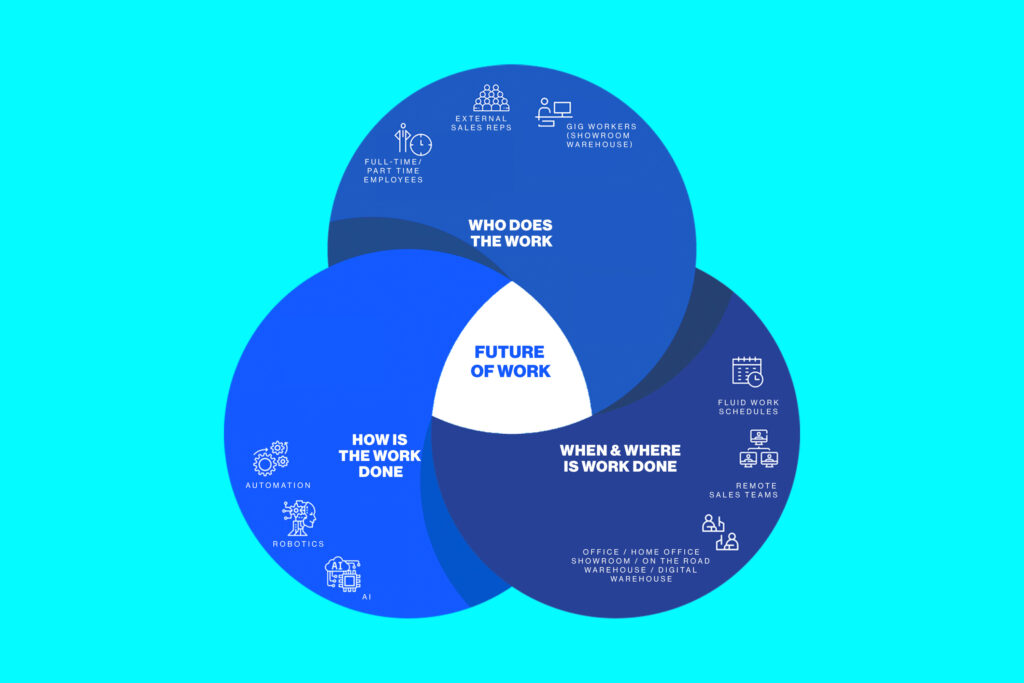
It’s still January for another few days, that month of the year when we are heavily concerned with the future: the actions that can bring us closer to goals and dreams, the potential for renewal, the chance to get it right. In the furniture industry, the IMC Las Vegas market provides one final opportunity to gather with peers in our industry and share thoughts about the future. Whether or not this year will bring a recession is for sure to be a hot conversation topic and for what it’s worth, our friends at Stump & Company have some reassuring takes. But in my view, one of the areas in this industry that has ample room for growth is how people work; the industry is inured to overworking. Because I cannot fly to Las Vegas (bike injury be damned) and have these conversations in person, I decided to share some thoughts on what renewal in the furniture industry might look like.
What do we talk about when we talk about the future of work in the furniture and home furnishings industry? It’s how work, workers, and the workplace will change in the coming years—the three elements that experts agree are core to understanding the future of work. “The future of work” is on a lot of people’s minds! A few months ago, Forbes tallied the frontrunners in this space, a motley crew of corporate leaders, startup founders, activists, and researchers whose work impacts millions of people. For the time being, employees from the furniture and home furnishings industry were not visible enough to be included in the Forbes list but we are confident that in the coming years, employees in industries or professions that have been underserved by technology will receive more attention for their software woes. (The current Forbes list does include several vertical technology solutions such as a Linkedin for nurses, or email and intranet for “desk-less workers.”)

WORK: Word hard for your money, not your tools
The work in furniture and home furnishings wholesaling revolves around turning inventory into profit, not costs. When wholesalers sell goods to retailers, hospitality businesses, and designers, their employees need quick, accurate answers to any and all inventory questions. How do they currently get these answers? Sometimes an employee takes data from one software program (e.g. an ERP) and enters it into another software program (e.g. a sales application, shipping software, an e-commerce website, etc.) because these programs do not “talk” amongst themselves. Other times, companies rely only on spreadsheets that don’t have collaboration capabilities, support for error tracing, auditing or revision control (knowing who changed what and when).
“Your digital tools should work for you, you should not work for your digital tools.”
Software programs are called digital tools but in our industry, all the focus went towards getting something “digital.” It’s no secret that most of the current digital tools used in the industry are not right for the task at hand. Walk around the Las Vegas market and you’ll catch glimpses of conversations about ERPs or sales applications that would make anyone want to put their therapist on speed dial. The heavy focus on digitization was a result of to the industry being late to the digital party, which caused stress and shame especially during the pandemic. But in the coming years, digitization will affect nearly all jobs. This is all to say: the obvious path forward is digital but how do you choose the right tool for your business? I want to steer the conversation toward the usefulness of software as a digital tool in the furniture industry. We believe your digital tools should work for you, you should not work for your digital tools. At Step-up Today, our approach to building such tools is to fast-track the work of any department:
1) No disjointed systems. An activity timeline module for customers, inventory, and orders. On this timeline, anyone with the right permission can see live inventory data, previous sales, showroom notes, customer support emails, and financial docs, arranged in chronological order.
2) No dirty data. Our collision detector flags duplicate entries. Plus, we offer format standardizing and address validation APIs for speedy address accuracy checks (zip codes, street name abbreviations).
3) Access anywhere and anytime: one universal app for mobile iOS and Android, and a desktop web portal.
At the end of the day, the goods sold in the furniture and home furnishings industry bring joy and comfort to their end customers. Those who work in this industry should not experience the opposite of joy in their day-to-day jobs. Our goal is to blow them away with delight.
WORKERS: Collaborate, don’t commiserate.
Almost 90% of furniture wholesalers have under 20 FTEs; 50% have under 5. External sales teams that work remotely on different time zones are a crucial part of the industry workforce. These hybrid teams are sometimes supplemented by gig workers who staff showrooms and warehouses during market time. The pandemic illustrated the tension points of this hybrid workforce: transparency and collaboration. External sales teams relied on the home office team to get information about customers or inventory. Customer support staff fended support requests from individual email addresses leaving few records of interaction for their department colleagues. Leadership relied on staff to prepare KPI reports about customers, operations, and supply chains.
“Our goal is to support employees develop new capabilities AND new mindsets.”
There was a mismatch here: the workforce was flexible but the tools were rigid. It was a no brainer for us that everyone needed access to data about customers, inventory, and orders when and where they were. Flexibility and customization are key tenets of our applications. We help leaders determine and support the technology aspirations of each department. Our goal is to support employees develop new capabilities AND new mindsets.
1) Flexible and secure workflows. All employees have access rights based on each company’s business processes (document level, user level, or system level rights). External sales teams have a premium web portal for reporting, shipping, data export in multiple formats, print capabilities, and advanced filtering & searching. Customer support staff can communicate with customers directly from the system, log all crucial decisions and give all stakeholders visibility into who’s doing what and when.
2) Customized dashboards and reporting for each department. Automated email reports can be set up on demand and we are working on a voice-operated plugin.
3) Automations. From the automated allocation of leads and customers based on a territory to automated preset customer support follow-up, we eliminate the grunt work and free up time for high-quality tasks.
WORKPLACE
The sites where the work in the furniture industry gets done are as diverse as they come: the showroom, the road, the office, the home office, the warehouse, a plane, a manufacturing plant, etc. Building a home base where all these employees can return for questions and updates was something that felt urgent. Our focus was to create “rooms” and “keys” for everyone to come home when they needed and wanted.
This solution turned out to be an integrated cloud platform that can support the end-to-end business operations of a wholesaler. Think of it like a digital office with no messy file cabinets that can be accessed by employees in all departments from any type of device. In fact, at this moment it’s the only universal application in this industry.
In conclusion, I want to paraphrase Daniel Dines, a fellow Romanian, that made the Forbes list about the future of work: “Would you eat a steak with plastic cutlery?” Sorry to miss seeing all of you in Las Vegas and wishing you all a great market.
Leave a Reply